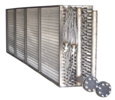Are your chilled water coils freezing this winter?

The unpredictable weather this winter can really impact chilled water coils. As you probably know, chilled water coils are used in a wide variety of HVAC systems, including air cooling and dehumidifying, and performance varies from application to application.
Chilled water coils are typically used to cool or remove moisture from air streams. The air to be cooled moves through the fins, and water or an ethylene or propylene glycol solution moves through the tubes. Most chilled water coils have air entering the system at a temperature ranging from 75° F to 95° F, while chilled water enters the coil at a temperature around 45° F. The chilled water may come from an onsite source, an offsite utility or another source of chilled water. As warm air passes across the chilled water coil and contacts the cold surface, heat transfers from the water flowing through the tubes to the air entering the coil.
Emergent Coils offers a handy Sizing Guide video to show you exactly how to measure the casing height, number of feeds, number of rows, fins per inch and other key elements of your new chilled water coils.
We have state of the art software that we can use to run performance. For a detailed performance run tailored to your situation, please email sales@emergentcoils.com with as many of the following details as you have available for your chilled water coils:• Coil model number• Duct size• Air Flow Rate in CFM (cubic feet per minute)• Entering Air Dry Bulb Temperature in °F• Entering Air Wet Bulb Temperature in °F (cooling coils only)• Fluid flow rate in GPM (gallons per minute, for water coils only)• Entering fluid temperature in °F• Desired capacity in MBH or tons• Desired leaving air temperature in °FEven if you don’t need to replace your chilled water coils today, be proactive and order chilled water coils now to avoid expedited prices.
